Rebecca D. Elswick's Blog, page 2
October 17, 2018
Loch Ness and the Glencoe Mountains
Do you believe? Part II of my Scotland blog. In America we have among other unexplained legends, Big Foot, Moth Man, and Sasquatch. The Irish have Leprechauns and Faeries, and Scotland has the Loch Ness Monster. These creatures appear and disappear throughout time, with reports of sightings popping up in news reports. I recently got to travel to Scotland and took a boat ride down Loch Ness. It was a cold and windy day, but the sky was clear and a brilliant blue. The sun had little warmth, but it bathed the water with light, turning it from steely gray to raven black. (The color of the water is so dark because of the high peat content.) A perfect day for a sighting! Alas, Nessie did not make an appearance! (Except in the gift shop.)
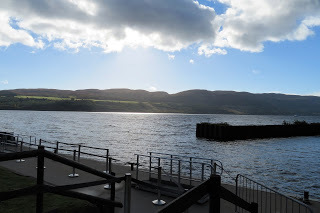
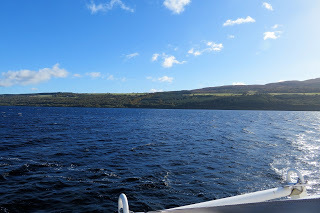

A 'loch' in Scotland means lake and Loch Ness is the second largest loch, second to Loch Lomond, but it is the largest by volume with its deepest point of 126 fathoms or 755 ft. It runs for 23 miles, stretching from Fort William in the west of the Scottish Highlands, to Inverness in the north. It is 2 1/2 miles wide.Loch Ness is freshwater and filled with fish, but none are visible because the water is so dark. And by the way, don't think of swimming in Loch Ness. The water temperature stays around 40 degrees, year round.
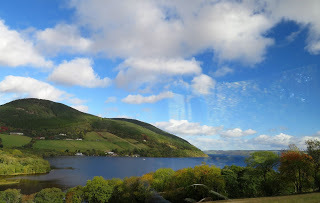 Our tour group was cautioned NOT to joke with the Scots about Nessie because many DO believe the Loch Ness Monster is real and most have stories about "a friend of a friend of a friend" who once spotted the beast. Descriptions vary, but most are of a dark dinosaur-like creature with a long neck. Feeling brave, I asked our bus driver if he believed in Nessie. He sat silent for a moment before saying, "No, I don't believe there is a monster." Only to follow that with, "But there is something in there that eats all of the fish."
Our tour group was cautioned NOT to joke with the Scots about Nessie because many DO believe the Loch Ness Monster is real and most have stories about "a friend of a friend of a friend" who once spotted the beast. Descriptions vary, but most are of a dark dinosaur-like creature with a long neck. Feeling brave, I asked our bus driver if he believed in Nessie. He sat silent for a moment before saying, "No, I don't believe there is a monster." Only to follow that with, "But there is something in there that eats all of the fish."
Along the coast of Loch Ness is Urquhart Castle, one of the largest in area in Scotland. The present ruins date from the 13th to the 16th centuries, but they are built on the site of an early medieval fortification. In the 14th century, the castle was in the midst of many wars for Scottish independence. It even had a draw-bridge!
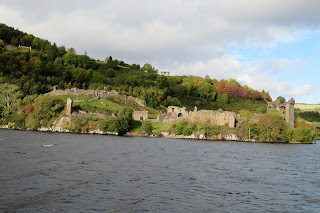
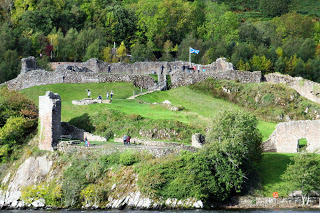
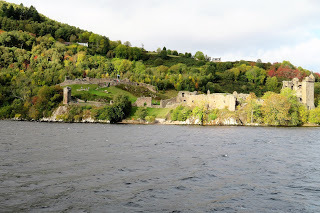
 After giving up our search for Nessie, we drove down the glen to the mountains. Like Loch Ness, this ares is near Inverness and in the Lochaber area of the Scottish Highlands, lying at the north-west end of the glen, part of County Argyll. (Ever buy any argyll socks?)
After giving up our search for Nessie, we drove down the glen to the mountains. Like Loch Ness, this ares is near Inverness and in the Lochaber area of the Scottish Highlands, lying at the north-west end of the glen, part of County Argyll. (Ever buy any argyll socks?)
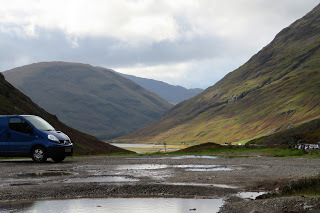
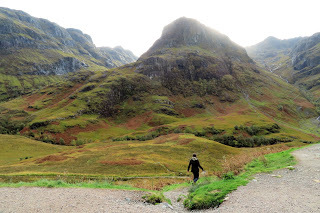 My words can't describe their raw-bone beauty.
My words can't describe their raw-bone beauty.
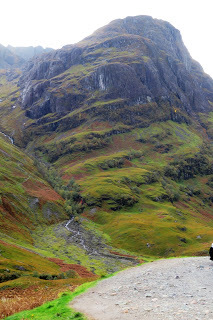
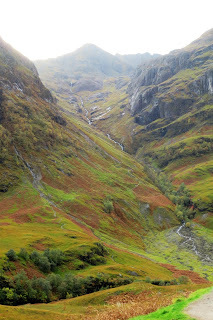 Nor can I describe their majestic height. They appeared to reach into the sky, disappearing into heaven.
Nor can I describe their majestic height. They appeared to reach into the sky, disappearing into heaven.
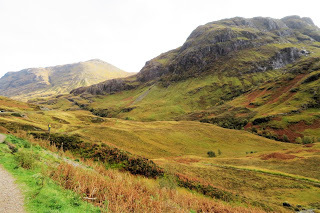
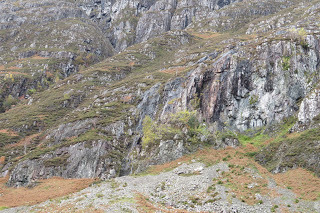
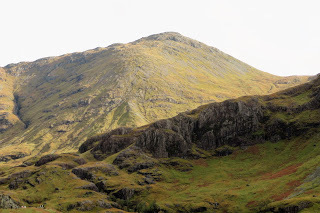 I left these mountains thinking, "No wonder the Scots emigrated to our mountains in central Appalachia. If they could live in these mountains, our mountains must have felt like home."
I left these mountains thinking, "No wonder the Scots emigrated to our mountains in central Appalachia. If they could live in these mountains, our mountains must have felt like home."




A 'loch' in Scotland means lake and Loch Ness is the second largest loch, second to Loch Lomond, but it is the largest by volume with its deepest point of 126 fathoms or 755 ft. It runs for 23 miles, stretching from Fort William in the west of the Scottish Highlands, to Inverness in the north. It is 2 1/2 miles wide.Loch Ness is freshwater and filled with fish, but none are visible because the water is so dark. And by the way, don't think of swimming in Loch Ness. The water temperature stays around 40 degrees, year round.
 Our tour group was cautioned NOT to joke with the Scots about Nessie because many DO believe the Loch Ness Monster is real and most have stories about "a friend of a friend of a friend" who once spotted the beast. Descriptions vary, but most are of a dark dinosaur-like creature with a long neck. Feeling brave, I asked our bus driver if he believed in Nessie. He sat silent for a moment before saying, "No, I don't believe there is a monster." Only to follow that with, "But there is something in there that eats all of the fish."
Our tour group was cautioned NOT to joke with the Scots about Nessie because many DO believe the Loch Ness Monster is real and most have stories about "a friend of a friend of a friend" who once spotted the beast. Descriptions vary, but most are of a dark dinosaur-like creature with a long neck. Feeling brave, I asked our bus driver if he believed in Nessie. He sat silent for a moment before saying, "No, I don't believe there is a monster." Only to follow that with, "But there is something in there that eats all of the fish."Along the coast of Loch Ness is Urquhart Castle, one of the largest in area in Scotland. The present ruins date from the 13th to the 16th centuries, but they are built on the site of an early medieval fortification. In the 14th century, the castle was in the midst of many wars for Scottish independence. It even had a draw-bridge!



 After giving up our search for Nessie, we drove down the glen to the mountains. Like Loch Ness, this ares is near Inverness and in the Lochaber area of the Scottish Highlands, lying at the north-west end of the glen, part of County Argyll. (Ever buy any argyll socks?)
After giving up our search for Nessie, we drove down the glen to the mountains. Like Loch Ness, this ares is near Inverness and in the Lochaber area of the Scottish Highlands, lying at the north-west end of the glen, part of County Argyll. (Ever buy any argyll socks?) 
 My words can't describe their raw-bone beauty.
My words can't describe their raw-bone beauty.

 Nor can I describe their majestic height. They appeared to reach into the sky, disappearing into heaven.
Nor can I describe their majestic height. They appeared to reach into the sky, disappearing into heaven.


 I left these mountains thinking, "No wonder the Scots emigrated to our mountains in central Appalachia. If they could live in these mountains, our mountains must have felt like home."
I left these mountains thinking, "No wonder the Scots emigrated to our mountains in central Appalachia. If they could live in these mountains, our mountains must have felt like home."

Published on October 17, 2018 12:01
October 16, 2018
A Visit to Scotland - Culloden Moor
I've had so much interest in my recent trip to Scotland and Ireland that I thought it was a good time to revive my blogging skills. I'll begin with Scotland and Culloden Moor.
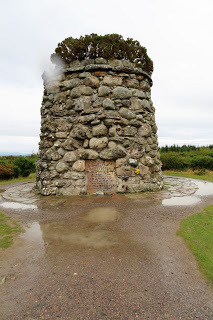 Monument to The Battle of Culloden
Monument to The Battle of Culloden
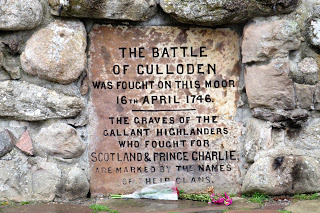
It was a thrill to visit Culloden Moor for several reasons. First, it has historical significance to my ancestors and southwestern Virginia. I swear there are as many, if not more, redheads here than in Scotland and Ireland! I also am a big fan of the Outlander series. If you're not a fan, just know that Outlander is a series of books by Diana Gabladon, currently totaling 8, with number 9 coming soon. Outlander is also a TV series on Starz, but this is not a blog about Outlander! I mention it because preparations for the Battle of Culloden Moor begin at the end of season 2 (Dragonfly in Amber) with the battle taking place at the beginning of season 3 (Voyager). A battle they recreated on Culloden Moor that is near Inverness, Scotland.
Historical Significance of Culloden Moor
As is inscribed on the stone monument pictured above, the Battle of Culloden took place 16 April 1746. It was the last battle fought on British soil. It was also the last in a series of battles between the Jacobites and the British that ended the hope of putting James Stuart, a Catholic, on the throne in England, and thus overthrowing the Hanover kings. James Stuart was exiled in Italy, and his supporters were called Jacobites. The Jacobite rising began in 1745 led by James Stuart's son, Charles Edward Stuart, who first tried raising support in France before turning to the Catholic clans of Scotland.
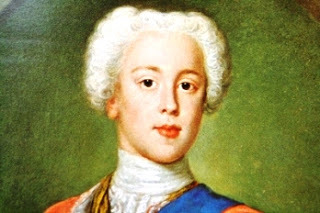 Charles,whose looks had earned him the description bonnie, the Scottish word for pretty, was known as "Bonnie Prince Charlie" and the "The Young Pretender". Charles first went to France, but the ships he obtained were damaged by storms, so he was forced to abandon France and travel to Scotland. He had many clans who supported him, Catholic and Protestant, so he was able to raise an army of approximately 6,000. Charles was only 26 and lacked military skills, and the victory of early battles such as Prestonpans spurred him on, but the Duke of Cumberland, who was King George II's son, was in hot pursuit. He caught up with him on Culloden Moor, 16 April 1746.
Charles,whose looks had earned him the description bonnie, the Scottish word for pretty, was known as "Bonnie Prince Charlie" and the "The Young Pretender". Charles first went to France, but the ships he obtained were damaged by storms, so he was forced to abandon France and travel to Scotland. He had many clans who supported him, Catholic and Protestant, so he was able to raise an army of approximately 6,000. Charles was only 26 and lacked military skills, and the victory of early battles such as Prestonpans spurred him on, but the Duke of Cumberland, who was King George II's son, was in hot pursuit. He caught up with him on Culloden Moor, 16 April 1746.
Culloden Moor
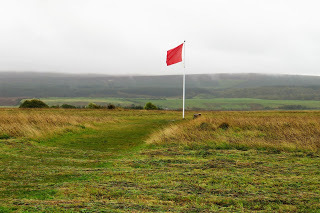
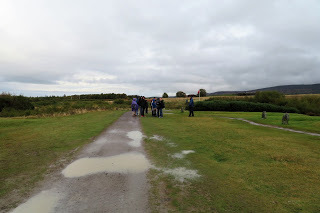
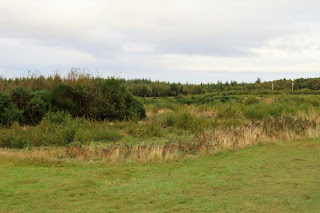 In the distance are Scotland's flags, marking where the Jacobites stood for battle.
In the distance are Scotland's flags, marking where the Jacobites stood for battle.
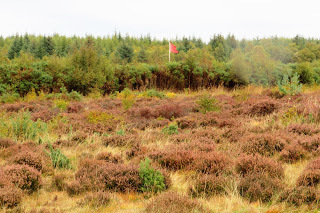 Prince Charles chose to fight on this flat, boggy land against the advice of his generals, one of which was Lord George Murray. The British had cannons, and the red flags in the pictures show where the British army amassed. The British had 8,000 soldiers. The Jacobites had about 5,000 which consisted of some Irish and French. The Jacobites did have muskets and some artillery, but due to the boggy ground, they had trouble transporting it. The Scots had 200 mounted men to Britian's 800. Many historians believe it was the benefit of Dragoons on horseback with swords and blades that was the biggest advantage in the fight.
Prince Charles chose to fight on this flat, boggy land against the advice of his generals, one of which was Lord George Murray. The British had cannons, and the red flags in the pictures show where the British army amassed. The British had 8,000 soldiers. The Jacobites had about 5,000 which consisted of some Irish and French. The Jacobites did have muskets and some artillery, but due to the boggy ground, they had trouble transporting it. The Scots had 200 mounted men to Britian's 800. Many historians believe it was the benefit of Dragoons on horseback with swords and blades that was the biggest advantage in the fight.

The battle ground has large stones with the names of Scottish clans that mark the places where the clansmen are buried in mass graves. It is estimated that between 1,500 to 2,000 Jacobites were killed, and 154 were captured. Most of those captured were executed.
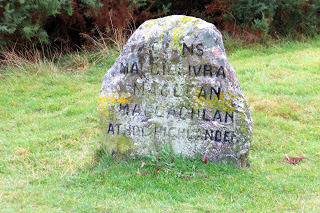 This stone has several clan names with one familiar to me in southwestern Virginia: McClanahan.
This stone has several clan names with one familiar to me in southwestern Virginia: McClanahan.
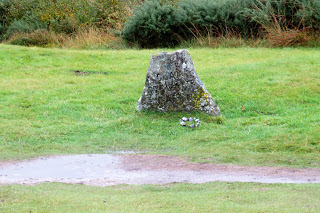 Clan Stewart of Appin
Clan Stewart of Appin
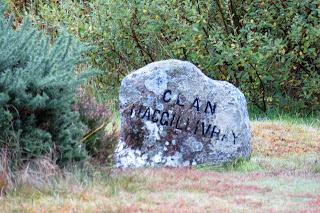 Clan MacGillivray
Clan MacGillivray
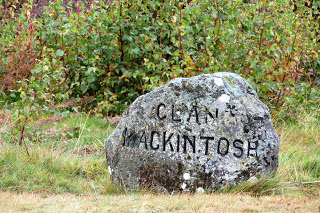 Clan MacKintosh
Clan MacKintosh
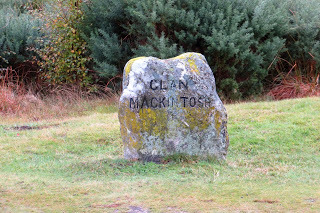 A second marker for Clan MacKintosh
A second marker for Clan MacKintosh
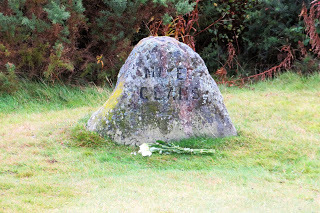 Mixed Clans: There were many other clans represented that day and they too were buried in mass graves.
Mixed Clans: There were many other clans represented that day and they too were buried in mass graves.
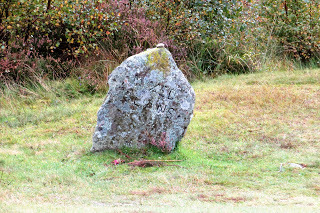 Mixed Clans - Another mass grave of mixed clans.
Mixed Clans - Another mass grave of mixed clans.
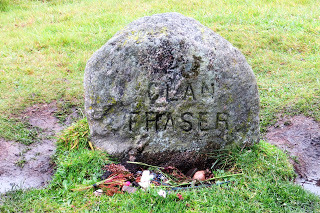 Clan Fraser of Lovat
Clan Fraser of Lovat
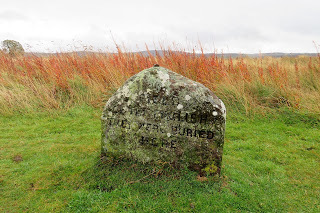 The stone marks where the British soldiers were buried. Approximately 240 to 400 British soldiers were killed.
The stone marks where the British soldiers were buried. Approximately 240 to 400 British soldiers were killed.
What happened to the Bonnie Prince?
Charles ran away from the battle, and although many highlanders saw him and even helped him escape, he was not given over to the British even though a reward of 30,000 pounds was offered. Charles Edward Stuart hid among the moors of Scotland until, disguised as a woman, yes a woman - an Irish maid named Betty Burke, he was put into a boat and taken to the Isle of Sky where a ship awaited to take him to France. He lived in exile the rest of his life, becoming an alcoholic and dying at age 67 of a stroke.
 Monument to The Battle of Culloden
Monument to The Battle of Culloden
It was a thrill to visit Culloden Moor for several reasons. First, it has historical significance to my ancestors and southwestern Virginia. I swear there are as many, if not more, redheads here than in Scotland and Ireland! I also am a big fan of the Outlander series. If you're not a fan, just know that Outlander is a series of books by Diana Gabladon, currently totaling 8, with number 9 coming soon. Outlander is also a TV series on Starz, but this is not a blog about Outlander! I mention it because preparations for the Battle of Culloden Moor begin at the end of season 2 (Dragonfly in Amber) with the battle taking place at the beginning of season 3 (Voyager). A battle they recreated on Culloden Moor that is near Inverness, Scotland.
Historical Significance of Culloden Moor
As is inscribed on the stone monument pictured above, the Battle of Culloden took place 16 April 1746. It was the last battle fought on British soil. It was also the last in a series of battles between the Jacobites and the British that ended the hope of putting James Stuart, a Catholic, on the throne in England, and thus overthrowing the Hanover kings. James Stuart was exiled in Italy, and his supporters were called Jacobites. The Jacobite rising began in 1745 led by James Stuart's son, Charles Edward Stuart, who first tried raising support in France before turning to the Catholic clans of Scotland.
 Charles,whose looks had earned him the description bonnie, the Scottish word for pretty, was known as "Bonnie Prince Charlie" and the "The Young Pretender". Charles first went to France, but the ships he obtained were damaged by storms, so he was forced to abandon France and travel to Scotland. He had many clans who supported him, Catholic and Protestant, so he was able to raise an army of approximately 6,000. Charles was only 26 and lacked military skills, and the victory of early battles such as Prestonpans spurred him on, but the Duke of Cumberland, who was King George II's son, was in hot pursuit. He caught up with him on Culloden Moor, 16 April 1746.
Charles,whose looks had earned him the description bonnie, the Scottish word for pretty, was known as "Bonnie Prince Charlie" and the "The Young Pretender". Charles first went to France, but the ships he obtained were damaged by storms, so he was forced to abandon France and travel to Scotland. He had many clans who supported him, Catholic and Protestant, so he was able to raise an army of approximately 6,000. Charles was only 26 and lacked military skills, and the victory of early battles such as Prestonpans spurred him on, but the Duke of Cumberland, who was King George II's son, was in hot pursuit. He caught up with him on Culloden Moor, 16 April 1746.Culloden Moor


 In the distance are Scotland's flags, marking where the Jacobites stood for battle.
In the distance are Scotland's flags, marking where the Jacobites stood for battle. Prince Charles chose to fight on this flat, boggy land against the advice of his generals, one of which was Lord George Murray. The British had cannons, and the red flags in the pictures show where the British army amassed. The British had 8,000 soldiers. The Jacobites had about 5,000 which consisted of some Irish and French. The Jacobites did have muskets and some artillery, but due to the boggy ground, they had trouble transporting it. The Scots had 200 mounted men to Britian's 800. Many historians believe it was the benefit of Dragoons on horseback with swords and blades that was the biggest advantage in the fight.
Prince Charles chose to fight on this flat, boggy land against the advice of his generals, one of which was Lord George Murray. The British had cannons, and the red flags in the pictures show where the British army amassed. The British had 8,000 soldiers. The Jacobites had about 5,000 which consisted of some Irish and French. The Jacobites did have muskets and some artillery, but due to the boggy ground, they had trouble transporting it. The Scots had 200 mounted men to Britian's 800. Many historians believe it was the benefit of Dragoons on horseback with swords and blades that was the biggest advantage in the fight.
The battle ground has large stones with the names of Scottish clans that mark the places where the clansmen are buried in mass graves. It is estimated that between 1,500 to 2,000 Jacobites were killed, and 154 were captured. Most of those captured were executed.
 This stone has several clan names with one familiar to me in southwestern Virginia: McClanahan.
This stone has several clan names with one familiar to me in southwestern Virginia: McClanahan. Clan Stewart of Appin
Clan Stewart of Appin Clan MacGillivray
Clan MacGillivray Clan MacKintosh
Clan MacKintosh A second marker for Clan MacKintosh
A second marker for Clan MacKintosh Mixed Clans: There were many other clans represented that day and they too were buried in mass graves.
Mixed Clans: There were many other clans represented that day and they too were buried in mass graves.  Mixed Clans - Another mass grave of mixed clans.
Mixed Clans - Another mass grave of mixed clans. Clan Fraser of Lovat
Clan Fraser of Lovat The stone marks where the British soldiers were buried. Approximately 240 to 400 British soldiers were killed.
The stone marks where the British soldiers were buried. Approximately 240 to 400 British soldiers were killed.What happened to the Bonnie Prince?
Charles ran away from the battle, and although many highlanders saw him and even helped him escape, he was not given over to the British even though a reward of 30,000 pounds was offered. Charles Edward Stuart hid among the moors of Scotland until, disguised as a woman, yes a woman - an Irish maid named Betty Burke, he was put into a boat and taken to the Isle of Sky where a ship awaited to take him to France. He lived in exile the rest of his life, becoming an alcoholic and dying at age 67 of a stroke.
Published on October 16, 2018 15:35
May 21, 2015
The Writer's Voice Entry: Query and first 250 words of Truth in Dreams
Hello! I am excited to post the query letter and first 250 words of my new novel,
Truth in Dreams
. I look forward to any comments and suggestions from my readers.
Rebecca
Dear Writer's Voice Editors,
When cosmopolitan Margaret Whitefield moves to a small town, the last person she expects to meet is a woman as miserable in her marriage as she is, but on their daughter’s first day of kindergarten, Margaret meets Hannah Lively. Friendship blooms for this unlikely pair, and soon they confide in each other why they don’t leave their husbands. Shy scholarly Margaret has the financial means, but she is emotionally devastated by her daughter’s battle with cancer, and her own mother’s emotional detachment. Hannah has dreamed her whole life of leaving this little Appalachian town behind and she almost made it, but an unplanned pregnancy destroyed her dreams of a college degree. It isn’t until the friends make a pact to leave their husbands when their daughters graduate from high school, that they discover there is indeed, Truth in Dreams.
Margaret and Hannah’s journey of self-discovery is rife with mystery and superstition. Hannah’s grandmother, called Granny Zee, is renowned for the curative remedies she makes from the mountain plants, and fabled for her ability to speak to spirits. Hannah is in fact, from a long line of Appalachian granny witches and midwives. When Margaret can no longer excuse her daughter’s bizarre ability to find lost things as coincidence, it is Granny Zee who recognizes the child’s gift - what the mountain people call, the second sight. Granny helps the child to understand her abilities, just as she teaches Margaret and Hannah how to heal the body and the spirit.
Truth in Dreams (109,000 words) is a savory dish of women's fiction that sits in that sweet spot between literary and commercial fiction. I am a sixth generation Appalachian living in the coalfields of southwestern Virginia. My grandmother was an herbalist and her mother was a midwife, and both were known in these mountains as healers. All of Granny Zee’s remedies and recipes have been gathered from my family and other folks from central Appalachia.
I am a hybrid author, traditionally and independently published, just waiting for an agent who will foster my literary debut! My first novel, Mama’s Shoes was published by Writer’s Digest as the result of winning their Pitch2Win Contest in 2011. Mama’s Shoes was awarded the WD Mark of Quality and was runner-up for Foreword Magazine’s 2012 Book of the year. As a result, I was a panelist at the Writer’s Digest Conference in New York. I have an established audience, website, blog, and social media presence. Endorsements from authors Lee Smith (Guests on Earth) and Amy Greene (Long Man) grace Mama's Shoes cover. I have had numerous short stories and nonfiction published in anthologies and periodicals. I currently direct the Writing Center at the Appalachian School of Law, and I am a teacher-consultant for the Appalachian Writing Project at UVA-Wise.
Thank you for your time and consideration.
Sincerely,
Rebecca D. Elswick
Truth in Dreams
Margaret Whitefield faltered when she saw the long hallway. The worst days of her life had begun just like this – a seemingly harmless journey down an ordinary hallway. Margaret sighed. Why should today be any different? Addie tugged at her mother’s hand. She half-stepped half-skipped along the corridor. Her Tinker Bell backpack swished back and forth on her thin shoulders. Addie pointed at the bright posters, decorating the walls of Coal Valley Elementary School, but Margaret noticed none of them. She couldn’t stop watching parents say good-bye to their children. Mother and daughter located the kindergarten classrooms at the end of the hall. A menagerie of brightly colored animals bloomed on the walls, and the entire area vibrated with childish voices. Addie’s teacher stood at the classroom door. She welcomed Addie and introduced herself as Miss Hall. While she talked, Margaret put her hand on top of Addie’s head and smoothed her short flyaway hair. It was beginning to grow faster, but the color was lighter than the chestnut brown it had been before the chemotherapy. Miss Hall assured Margaret her daughter would be fine and then said a firm good-bye. Margaret crouched down and hugged Addie. “Let go, Mama. You’re smushing me!” Addie giggled.Margaret stood and tried to plant a kiss on top of Addie's head, but she ducked and skipped through the door with a, "Bye, Mama." Margaret raised her hand to wave, but Addie didn't look back.
Rebecca
Dear Writer's Voice Editors,
When cosmopolitan Margaret Whitefield moves to a small town, the last person she expects to meet is a woman as miserable in her marriage as she is, but on their daughter’s first day of kindergarten, Margaret meets Hannah Lively. Friendship blooms for this unlikely pair, and soon they confide in each other why they don’t leave their husbands. Shy scholarly Margaret has the financial means, but she is emotionally devastated by her daughter’s battle with cancer, and her own mother’s emotional detachment. Hannah has dreamed her whole life of leaving this little Appalachian town behind and she almost made it, but an unplanned pregnancy destroyed her dreams of a college degree. It isn’t until the friends make a pact to leave their husbands when their daughters graduate from high school, that they discover there is indeed, Truth in Dreams.
Margaret and Hannah’s journey of self-discovery is rife with mystery and superstition. Hannah’s grandmother, called Granny Zee, is renowned for the curative remedies she makes from the mountain plants, and fabled for her ability to speak to spirits. Hannah is in fact, from a long line of Appalachian granny witches and midwives. When Margaret can no longer excuse her daughter’s bizarre ability to find lost things as coincidence, it is Granny Zee who recognizes the child’s gift - what the mountain people call, the second sight. Granny helps the child to understand her abilities, just as she teaches Margaret and Hannah how to heal the body and the spirit.
Truth in Dreams (109,000 words) is a savory dish of women's fiction that sits in that sweet spot between literary and commercial fiction. I am a sixth generation Appalachian living in the coalfields of southwestern Virginia. My grandmother was an herbalist and her mother was a midwife, and both were known in these mountains as healers. All of Granny Zee’s remedies and recipes have been gathered from my family and other folks from central Appalachia.
I am a hybrid author, traditionally and independently published, just waiting for an agent who will foster my literary debut! My first novel, Mama’s Shoes was published by Writer’s Digest as the result of winning their Pitch2Win Contest in 2011. Mama’s Shoes was awarded the WD Mark of Quality and was runner-up for Foreword Magazine’s 2012 Book of the year. As a result, I was a panelist at the Writer’s Digest Conference in New York. I have an established audience, website, blog, and social media presence. Endorsements from authors Lee Smith (Guests on Earth) and Amy Greene (Long Man) grace Mama's Shoes cover. I have had numerous short stories and nonfiction published in anthologies and periodicals. I currently direct the Writing Center at the Appalachian School of Law, and I am a teacher-consultant for the Appalachian Writing Project at UVA-Wise.
Thank you for your time and consideration.
Sincerely,
Rebecca D. Elswick
Truth in Dreams
Margaret Whitefield faltered when she saw the long hallway. The worst days of her life had begun just like this – a seemingly harmless journey down an ordinary hallway. Margaret sighed. Why should today be any different? Addie tugged at her mother’s hand. She half-stepped half-skipped along the corridor. Her Tinker Bell backpack swished back and forth on her thin shoulders. Addie pointed at the bright posters, decorating the walls of Coal Valley Elementary School, but Margaret noticed none of them. She couldn’t stop watching parents say good-bye to their children. Mother and daughter located the kindergarten classrooms at the end of the hall. A menagerie of brightly colored animals bloomed on the walls, and the entire area vibrated with childish voices. Addie’s teacher stood at the classroom door. She welcomed Addie and introduced herself as Miss Hall. While she talked, Margaret put her hand on top of Addie’s head and smoothed her short flyaway hair. It was beginning to grow faster, but the color was lighter than the chestnut brown it had been before the chemotherapy. Miss Hall assured Margaret her daughter would be fine and then said a firm good-bye. Margaret crouched down and hugged Addie. “Let go, Mama. You’re smushing me!” Addie giggled.Margaret stood and tried to plant a kiss on top of Addie's head, but she ducked and skipped through the door with a, "Bye, Mama." Margaret raised her hand to wave, but Addie didn't look back.
Published on May 21, 2015 11:18
May 13, 2015
Ten Signs You Have Reached the Age of Comfort
If you find yourself becoming more and more demanding, adamant, and unrelenting about what is necessary to make you comfortable, content, and down-right happy, then you my friend, have reached one of life’s milestones. Call it middle-age, call it a revelation that comes with age, or call it reaching the age of entitlement, but when it does happen, check your driver’s license – that section that says: DOB – because you are getting - older.
What I’m referring to, of course, are those fundamentals of life that you insist upon. The things that matter the most. The items you will purchase without looking at the price tag because your comfort is more important than money. If you have reached the age when you say,” Damn the cost!” or you find that your way of thinking has become opinionated, then you’ve reached a pinnacle, (and have started down the other side.)
 1.
Toliet Paper.
When only “that brand” will do, then it’s happening. Somewhere around age 30, you start to notice that toilet papers are different, and not long after that, it begins to matter! Really matter.
1.
Toliet Paper.
When only “that brand” will do, then it’s happening. Somewhere around age 30, you start to notice that toilet papers are different, and not long after that, it begins to matter! Really matter.2. Underwear that’s NOT Fun to wear. Ladies, when you bypass the lacey panties and push-up bra for the cotton granny panties and stretched-out sport’s bra, and for that matter, gentlemen who hang on to those old underthings that are stretched to the max and full of holes, then you’ve reached the age when comfort matters most.
3. That morning beverage .
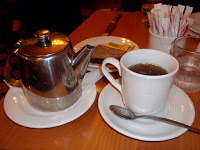 Yes, we know how much money we can save by making our own coffee or tea and taking it to work in our trusty, thermo-nuclear insulated adult sippy-cup. But if you’ve reached that point in your life when you gladly plop down your money for coffee at that specialty place, or you love driving up to the window and retrieving a lovely steaming cup someone else has already loaded with cream and sugar for you, then admit it – you’ve reached the summit of middle age.
Yes, we know how much money we can save by making our own coffee or tea and taking it to work in our trusty, thermo-nuclear insulated adult sippy-cup. But if you’ve reached that point in your life when you gladly plop down your money for coffee at that specialty place, or you love driving up to the window and retrieving a lovely steaming cup someone else has already loaded with cream and sugar for you, then admit it – you’ve reached the summit of middle age. 4.
Shoes.
If you’ve abandoned shoes with high heels and toes that pinch, for clogs with memory foam, then you’ve turned the corner. It’s okay to keep those lovely, stylish heels in your closet. You can even tell yourself you’re going to wear them again, and maybe you’ll slip them on for an evening out, but it’s those comfort-clogs you will search high and low for. It’s those cute flip flops you’ll shop for. It’s those comfortable shoes you will buy, even when they’re NOT on sale.
4.
Shoes.
If you’ve abandoned shoes with high heels and toes that pinch, for clogs with memory foam, then you’ve turned the corner. It’s okay to keep those lovely, stylish heels in your closet. You can even tell yourself you’re going to wear them again, and maybe you’ll slip them on for an evening out, but it’s those comfort-clogs you will search high and low for. It’s those cute flip flops you’ll shop for. It’s those comfortable shoes you will buy, even when they’re NOT on sale.5. It’s too hot! It’s too cold! Extreme temperatures never used to bother you, right? As kids, we played outside in the scorching sun and freezing cold. When we were twenty-somethings we sunbathed, slathered in oil, until the last scorching ray disappeared from the sky. In winter, we braved the freezing temperatures, building snowmen, having snowball fights and sledding. Now, we seek that lovely temperature controlled room! Can’t stand the heat; turn on the air conditioner! Can’t stand the cold; build a fire and turn up the thermostat.
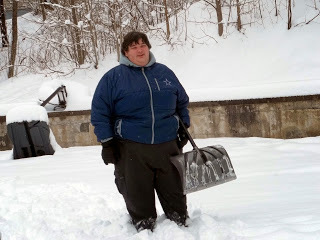
6. Where’s my glasses? If you have numerous pairs of reading glasses placed strategically around your house or wherever you might need to read something, then you my friend, are one of us.
7. A smaller laptop, please. When that nice big laptop with the big screen gets heavier and heavier, and carrying it around causes pain in your back and shoulder, it’s time to buy one of those new lightweight ones. Bigger is NOT always better, especially when you have to carry it.
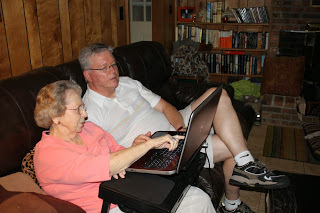
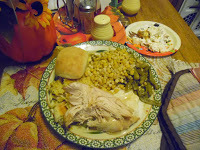 8.
Food.
Used to have a stomach of steel? Used to be able to eat anything, at any time, and not suffer for it? Fried foods never bothered you? How about spices? Now, if you eat certain foods past ten o’clock at night, you can’t sleep from stomach distress. Do you keep Tums or Rolaids handy? Thought so.
8.
Food.
Used to have a stomach of steel? Used to be able to eat anything, at any time, and not suffer for it? Fried foods never bothered you? How about spices? Now, if you eat certain foods past ten o’clock at night, you can’t sleep from stomach distress. Do you keep Tums or Rolaids handy? Thought so.9. A Schedule. Routine. Routine. Routine. How important is your schedule to you? As we get older, we become more fixed on a daily schedule – wake up time, bed time, meal times, even things like when we get a haircut, or go to the grocery store become scheduled. No more – fly by the seat of your pants.
10. Tolerance. Or Lack of Tolerance. One sure sign you’re getting older is your lack of tolerance for bullshit. The stupid, trivial, issues that consume others are not worth your time. The same goes for petty small-minded people. Out of the picture. As you get older, you lose tolerance for the petty-minded, mean-spirited people who want to gossip and cause uproar. Save your patience for those who deserve it.
Published on May 13, 2015 20:04
March 1, 2015
My Adventures in Outlander World
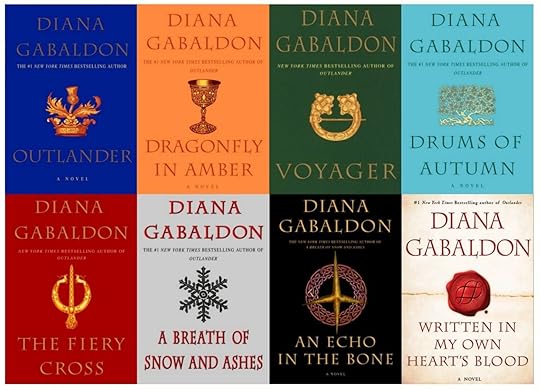 I resisted. I did! I told myself I’m not a fan of that genre – historical fiction/science fiction/adventure/romance – at least not all in the same story. Plus, my high school students were the ones who told me about Outlander, and they carried one of the series around with them like it was a membership in an exclusive club. Then the TV series was advertised and I realized it was based on the books I had heard so much about, so I watched the first episode. Instantly, I was hooked!! I couldn’t buy Outlander fast enough, and the minute I read the first chapter, I knew I was going to read every single Outlander book. And I did. Sometimes you need to “go through the stones” into another world.
I resisted. I did! I told myself I’m not a fan of that genre – historical fiction/science fiction/adventure/romance – at least not all in the same story. Plus, my high school students were the ones who told me about Outlander, and they carried one of the series around with them like it was a membership in an exclusive club. Then the TV series was advertised and I realized it was based on the books I had heard so much about, so I watched the first episode. Instantly, I was hooked!! I couldn’t buy Outlander fast enough, and the minute I read the first chapter, I knew I was going to read every single Outlander book. And I did. Sometimes you need to “go through the stones” into another world.I have always been a fan of books with strong characters over plot. As a writer, I believe if you get the characters right, the story will follow them, and the characters in Diana Gabaldon’s Outlander series are perfect. James Alexander Malcolm MacKenzie Fraser and Claire Elizabeth Beauchamp Randall Fraser. From the moment they were introduced on the page, I could see them, hear them, and even smell them. Jamie’s Scotch Highlander accent and Claire’s proper British voice rang in my ears. Not only the main characters, but the books are populated with wondrous figures that walk off the page and into your imagination.
Over the years, I have been disappointed by numerous TV series and movies based on books. It was wonderful to see a book come to life on the screen the way I had envisioned it. The actors were, in my opinion, perfect. As magnificent as the setting was, the characters were more so, proving my belief that if you get the characters right, the rest will fall into place.
Beginning with Outlander, the characters who live, fight, and die in Gabaldon’s imagination create their own world of myth and mystery, a world I enjoyed visiting. The history, romance, and adventure was just a bonus!
Published on March 01, 2015 19:33
February 10, 2015
Through His Eyes
Through His Eyes
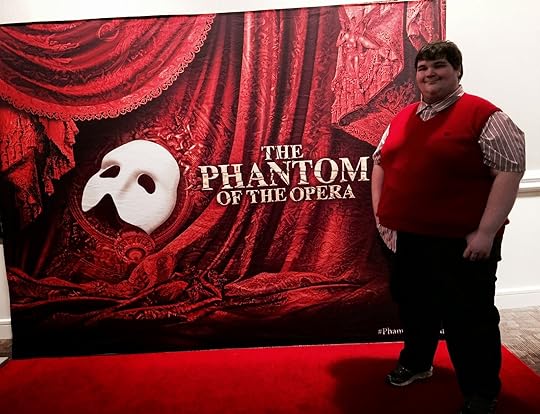
Shakespeare said, “The eyes are the window to the soul,” and after my weekend excursion to see “The Phantom of the Opera,” I believe the Bard of Avon was on to something. The performance was beyond fantastic – a superb cast, amazing sets, awesome special effects, melodious orchestra – and most of all, I got to see it with my youngest son. Ross has loved “The Phantom of the Opera” for years, and to see it performed live was his dream. When I discovered the Broadway tour was coming to Charlotte, North Carolina, I decided this was an opportunity I should go after with a club. And I did.
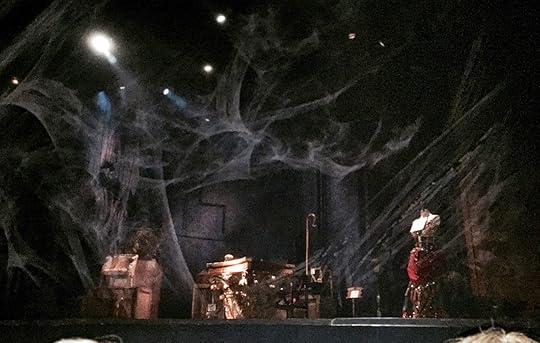
We sat in the second row! Second row! The orchestra pit was so close I could have spit on the musicians, but that would have been extremely unladylike and apt to cause untold difficulties. I did however, sneak a couple of pictures of the stage, even though the ushers were telling everyone no pictures were allowed until intermission. There is indeed, safety in numbers, and there were so many cell phones pointed at the stage within point-blank-range, it was impossible to see who was snapping. Then the lights went down and the orchestra started, and that’s when I began to watch the performance – through Ross’s eyes. Every emotion, every sensation shone in his eyes. Spellbound from the opening line, I would swear he didn’t breathe until the intermission. I will never forget his face when the first chord of the theme song burst forth like the sunrise. His face transformed, and I saw again, the little boy who once looked at a spider web like he could not believe there was such a wondrous thing in the world. Lost in the music, Ross was carried away by the phenomenon unfolding in front of him. A musician himself, he knew much more about “The Phantom of the Opera” than I could understand. He knew each song and recognized the beauty of that perfect moment when art and music come together. I watched him ride a wave of emotions, savoring every note of each song. And when the giant chandelier suspended over the audience came crashing down (extremely close to some heads), and literally exploded “fake” glass all over us, Ross squealed with delight. I know he will never forget the thrill of that moment, and I will never forget how it jumped from him to me like an electric current.

Throughout the performance, I was thankful I had fostered his love of music, encouraging him to be in the high school marching band. All three of my children are musicians, and my daughter a high school band director. I believe with all my heart the gift of music lasts forever. If you could have seen Ross watch “The Phantom of the Opera,” you would believe it too. The story is a timeless romance – the beautiful and talented woman (Christine), loved by her childhood friend (Raoul) goes from the unnoticed understudy to the star of the opera because the phantom, a hideously disfigured man, who haunts the opera house has visited her in her dreams, thereby mysteriously developing her talent. Known as the phantom of the opera, he falls in love with Christine and kidnaps her, taking her back to his lair in the hopes she will grow to love him. Even though the phantom is responsible for her amazing voice, when she sees him without his mask, she is repulsed. Meanwhile, Raoul leads the search for Christine, who in the end must choose between the phantom or Raoul. Does she love him? Perhaps, in the end she does, but she cannot love a hideous monster.
Published on February 10, 2015 21:32
October 27, 2014
Where I'm From
Where I’m From
 There is a swing on my back porch built by my husband’s grandfather. It is my favorite place to sit when the early morning light touches the mountains behind my house, and the mist hangs over their peaks like white lacy shawls. From my perch, I can watch the sun climb high into the sky and burn the mist away, revealing the deep greenness that is cooling to my eyes. As the swing dips to and fro, I marvel that these mountains are my home. My corner of Appalachia is southwestern Virginia, where the rugged mountains soar high into the sky. In spring and summer, they vibrate with green, but in the fall, they transform into a kaleidoscope of color. Man cannot duplicate the gilded color of the autumn leaves – saffron and sunflower yellows, russet and chestnut browns, and my favorite, reds that range from crimson to oxblood.
There is a swing on my back porch built by my husband’s grandfather. It is my favorite place to sit when the early morning light touches the mountains behind my house, and the mist hangs over their peaks like white lacy shawls. From my perch, I can watch the sun climb high into the sky and burn the mist away, revealing the deep greenness that is cooling to my eyes. As the swing dips to and fro, I marvel that these mountains are my home. My corner of Appalachia is southwestern Virginia, where the rugged mountains soar high into the sky. In spring and summer, they vibrate with green, but in the fall, they transform into a kaleidoscope of color. Man cannot duplicate the gilded color of the autumn leaves – saffron and sunflower yellows, russet and chestnut browns, and my favorite, reds that range from crimson to oxblood.
 Even in winter, the forest has a stark matchstick beauty like an old black and white photograph. When the snow falls, it softens the mountains craggy features into a fairytale landscape.
Even in winter, the forest has a stark matchstick beauty like an old black and white photograph. When the snow falls, it softens the mountains craggy features into a fairytale landscape.
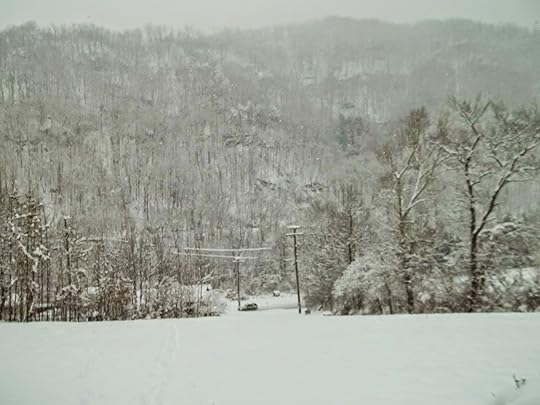
Like many of the people in these mountains, my family has lived here for generations, and we claim Ulster Scots’ ancestry. Our descendants were the people who left their homes in Northern Ireland and the lowlands of Scotland during the Great Migration that took place during the eighteenth century. Most Ulster Scots came first to Pennsylvania and as the land opportunities dried up, they migrated down into Virginia, some traveling into southwestern Virginia, western North Carolina, and eastern Tennessee and beyond. They were almost exclusively protestant Presbyterians looking for the opportunity to own land, and even though farming the rocky ridges of southwestern Virginia was a daunting task, it was far better than what they had left behind.The Ulster Scots, or the Scotch-Irish as they are usually called, brought more than their religion to Appalachia. Our traditional speech was influenced by the Scotch-Irish emigrants, and not the result of Elizabethan England influence. Growing up, I heard the Ulster-Scots influence on our language every day. My parents used the adjective “airish,” meaning windy and chilly, and they also warned me of “taking a backset,” a reversal of health, when they didn’t think I was taking care of myself after a cold or the flu. Both of those terms are Scotch-Irish as is “you’uns,” a contraction of “you” and “ones,” also seen in “young’un and big’uns.” Those words are just as much a part of central Appalachian culture as is our love of helping verbs and prepositions, also a result of our Scotch-Irish heritage. In Appalachia you may hear, ‘I was wondering if you “might could” help me?’ and ‘I “used to could” or “you might could.” You will also hear, “it’s a quarter “till” three” instead of the more traditional “it’s a quarter to three.” I recently heard a grandmother try to convince her grandson, who was sitting under a table in McDonalds, to come out. Apparently, he did not want to leave, and all of her attempts to convince him had failed. I walked up just as she said this preposition riddled sentence, ‘I said for you to get back up and out from under in there!’ In southwestern Virginia and other parts of Appalachia, our Scotch-Irish heritage influences the pronunciation of numerous words. I, myself, can’t distinguish between the pronunciation of “i” and “e” in words like “pin/pen, tin/ten, and bit/bet,” to the extent that I would have to see the written word before I could distinguish the meaning. Even our southern drawl with its love of stretching out vowels in short words like bad/ba-ud and bed/be-ud is attributed to our Ulster-Scots ancestors. After all, in NASCAR we don’t race cars, but rather we race ca-urs.The people of central Appalachia have inherited more from the Ulster-Scots than religion and language. Numerous surnames native to southwestern Virginia are western European (England, Ireland, Scotland and Wales) in origin, and are more telling of a person’s heritage than the blue eyes and red hair that favor so many of our residents. Often, Ulster-Scots’ emigrants changed their names to a more traditional spelling, an example being dropping the “O, Mc, Mac” part of the surname. “O” is really a word all by itself, it means "grandson". Only in recent years has it been attached to the surname with an apostrophe. “Mac” is the Gaelic word for son. It is now often abbreviated to "Mc.” Many surnames common to southwestern Virginia are Ulster-Scots in origin. Blackburn is commonplace and is found in several places in Scotland’s Lowlands, including Berwickshire, Sterlingshire, and Edinburgh. In Ulster many Blackburns claim the Sterlingshire decent. (ancestry.com)
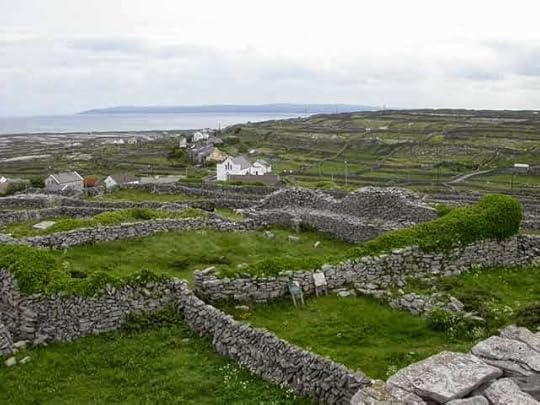 On a recent trip to Ireland, I visited the Aran Islands, population approximately two hundred. Our tour guide mentioned there were only nine surnames on the island and rattled them off. When he said Mullins, I said, “Wait! Did you say Mullins? There are a lot of Mullins where I live.” At first, I don’t think he believed me, and then he joked, “One bloke must have gotten in a boat because Mullins have lived on this island for centuries.” Other common Scotch-Irish surnames prevalent in southwestern Virginia, eastern Tennessee, southern West Virginia, and eastern Kentucky are Thompson, Sullivan, Horn, Ward, and my great-grandmother’s surname Williams, first recorded in Rockbridge County, Virginia. (ancestry.com)
On a recent trip to Ireland, I visited the Aran Islands, population approximately two hundred. Our tour guide mentioned there were only nine surnames on the island and rattled them off. When he said Mullins, I said, “Wait! Did you say Mullins? There are a lot of Mullins where I live.” At first, I don’t think he believed me, and then he joked, “One bloke must have gotten in a boat because Mullins have lived on this island for centuries.” Other common Scotch-Irish surnames prevalent in southwestern Virginia, eastern Tennessee, southern West Virginia, and eastern Kentucky are Thompson, Sullivan, Horn, Ward, and my great-grandmother’s surname Williams, first recorded in Rockbridge County, Virginia. (ancestry.com)
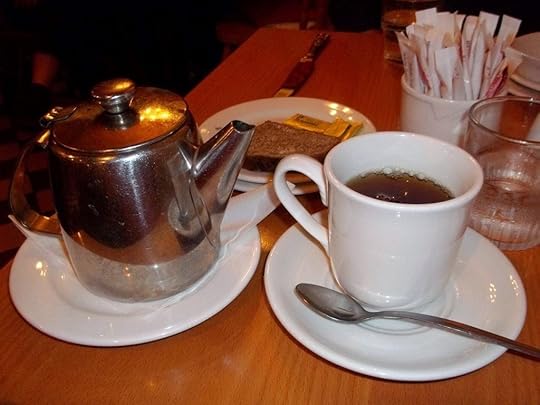 A lifelong resident of southwestern Virginia, I have experienced the religious fervor, clannish behavior, and fierce almost feudal behavior of protecting the family that is part of our Ulster Scots heritage. I know families with Scotch-Irish surnames who have lived in the same hollows in central Appalachia for more than two hundred years, and I have studied the Ulster Scots influence on our language. Even the mountain people’s love of moonshine came about because of the Scotsman’s’ and Irishman’s’ love for and lack of whiskey. (This American liquor made from corn is even more potent in its effect than true Scotch or Irish whiskey.) We still eat traditional Scotch-Irish foods like mashed potatoes and cabbage, and the ballads they brought from home are still sung here. We have their love of music and dance, and the roots of our blue grass music are in Ireland, Scotland, and England. Even our superstitions and belief in spirits can be traced to the Ulster Scots. They believed in fairies, goblins and ghosts and these beliefs crossed the Atlantic with them. It is from these immigrants that came the saying of “God bless you” when someone sneezes – done to ward off the evil spirits, of course.Nestled in these mountains, the Ulster Scots legacy has been preserved for centuries, but now, the modern world penetrates this fortress that once was only trespassed by the brave pioneers. As I admire them from my back porch swing, I realize these mountains have changed and will continue to change, and it is up to people like me to preserve our heritage by seeking out and writing down the stories of our ancestors.
A lifelong resident of southwestern Virginia, I have experienced the religious fervor, clannish behavior, and fierce almost feudal behavior of protecting the family that is part of our Ulster Scots heritage. I know families with Scotch-Irish surnames who have lived in the same hollows in central Appalachia for more than two hundred years, and I have studied the Ulster Scots influence on our language. Even the mountain people’s love of moonshine came about because of the Scotsman’s’ and Irishman’s’ love for and lack of whiskey. (This American liquor made from corn is even more potent in its effect than true Scotch or Irish whiskey.) We still eat traditional Scotch-Irish foods like mashed potatoes and cabbage, and the ballads they brought from home are still sung here. We have their love of music and dance, and the roots of our blue grass music are in Ireland, Scotland, and England. Even our superstitions and belief in spirits can be traced to the Ulster Scots. They believed in fairies, goblins and ghosts and these beliefs crossed the Atlantic with them. It is from these immigrants that came the saying of “God bless you” when someone sneezes – done to ward off the evil spirits, of course.Nestled in these mountains, the Ulster Scots legacy has been preserved for centuries, but now, the modern world penetrates this fortress that once was only trespassed by the brave pioneers. As I admire them from my back porch swing, I realize these mountains have changed and will continue to change, and it is up to people like me to preserve our heritage by seeking out and writing down the stories of our ancestors.Works Citedhttp://www.ancestry.com.
Published on October 27, 2014 20:06
October 2, 2014
Imagine
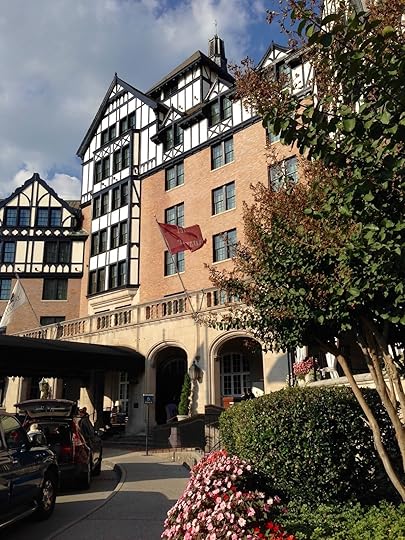
I’m sitting in this sumptuous lobby of The Hotel Roanoke in complete awe of my surroundings. I have never been here before and I wasn’t prepared for the feeling that came over me when I stepped through the door – I have traveled back in time. I keep looking at the people around me to reassure myself that I am still in the 21st century. I can’t shake the feeling that women, dripping with diamonds, and wearing elegant ball gowns will suddenly sweep through the door on the arm of mustached gentlemen in top hats and tails.
My writer’s senses have kicked into high gear. Everywhere I look is a chandelier, painting, carpet, piece of furniture – begging to be described as a scene from a Jane Austen-type novel. This is my first perception of The Hotel Roanoke. Now, let me tell you about my second.
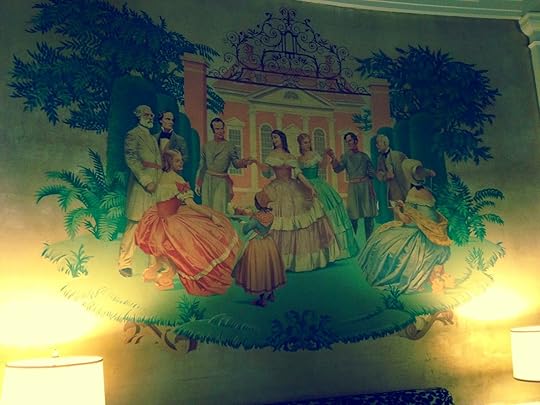 I got on the elevator, which by the way has a crystal chandelier, and went in search of my room. The moment I stepped out, the sensation that I had seen this long twisting and turning hallway before washed over me. Suddenly, I was in the movie “The Shining” and I will confess, I sprinted past room 237! (Stephen King fans will remember what was inside of room 237!) When I began to write this blog, I had to convince myself it was okay to type. Pictures of Jack Nicholson typing, ‘All work and no play make Jack a dull boy,’ ran through my head. Thank goodness it’s not winter! If one snowflake fell I would not be able to sleep here tonight!
I got on the elevator, which by the way has a crystal chandelier, and went in search of my room. The moment I stepped out, the sensation that I had seen this long twisting and turning hallway before washed over me. Suddenly, I was in the movie “The Shining” and I will confess, I sprinted past room 237! (Stephen King fans will remember what was inside of room 237!) When I began to write this blog, I had to convince myself it was okay to type. Pictures of Jack Nicholson typing, ‘All work and no play make Jack a dull boy,’ ran through my head. Thank goodness it’s not winter! If one snowflake fell I would not be able to sleep here tonight!


 Back downstairs, I watched the day fade away and the lights inside of the hotel come on. One by one, golden shadows cast a spell over the rooms. The sense that I had stepped though a portal into the past was stronger than ever. Now, I found myself avoiding those who shared my space. I didn’t want to be reminded that the time period I was imagining didn’t exist. I was jarred by men in golf shirts and women in shorts and flip flops. I wanted to see a horse-drawn carriage pull up to the doors. I wanted to see a debutante in a rose petal pink gown with a hooped skirt so wide she had to come through the door sideways. I wanted to catch a whiff of her perfume. I wantedto envy her white satin gloves, glowing silver in the muted lights. When laughter from the hotel restaurant drifted past me, scenes from every Henry James book I have ever read played like movie clips in my head. I could smell the fragrant coffee and taste the bread pudding with rum sauce. I could hear the tink of a China cup placed on its saucer. I knew that gentlemen dressed in dinner jackets with black velvet lapels would gather together after the meal in a room where they could smoke expensive cigars and drink brandy from heavy crystal glasses.
Back downstairs, I watched the day fade away and the lights inside of the hotel come on. One by one, golden shadows cast a spell over the rooms. The sense that I had stepped though a portal into the past was stronger than ever. Now, I found myself avoiding those who shared my space. I didn’t want to be reminded that the time period I was imagining didn’t exist. I was jarred by men in golf shirts and women in shorts and flip flops. I wanted to see a horse-drawn carriage pull up to the doors. I wanted to see a debutante in a rose petal pink gown with a hooped skirt so wide she had to come through the door sideways. I wanted to catch a whiff of her perfume. I wantedto envy her white satin gloves, glowing silver in the muted lights. When laughter from the hotel restaurant drifted past me, scenes from every Henry James book I have ever read played like movie clips in my head. I could smell the fragrant coffee and taste the bread pudding with rum sauce. I could hear the tink of a China cup placed on its saucer. I knew that gentlemen dressed in dinner jackets with black velvet lapels would gather together after the meal in a room where they could smoke expensive cigars and drink brandy from heavy crystal glasses.

Today, the writer in me rose up and stretched. The atmosphere at The Hotel Roanoke kicked my senses into overdrive, and I held on for an exhilarating ride! Tonight I will sleep in this hotel, rich with the spirit of another time. Perhaps my dreams will be of a world that exists only in our history. I would much rather dream of dancing in the ballroom under a ceiling painted to look like a summer sky than be a character in “The Shining” who has to open the door to Room 237!

Published on October 02, 2014 21:03
September 13, 2014
"Wait! I Didn't Say Hut!"
“Wait! I Didn’t Say Hut!”
 High school football season is in full swing, and last night I attended a game as an extraordinarily proud Band Mom. My son is a high school senior and is the bands only tuba player and as if that’s not reason enough, his sister is his band director. As I walked in with the band, I could feel a collective sense of walking into the Lion’s Den, since we were as my husband so eloquently said, “out-manned, out-classed, and out-gunned.” (Yes, we lost 66 – 8). The band members knew they had to play their hearts out – and they did, especially in the fourth quarter when you could see the spirits of the team disappear like a balloon spiraling into the sky.
High school football season is in full swing, and last night I attended a game as an extraordinarily proud Band Mom. My son is a high school senior and is the bands only tuba player and as if that’s not reason enough, his sister is his band director. As I walked in with the band, I could feel a collective sense of walking into the Lion’s Den, since we were as my husband so eloquently said, “out-manned, out-classed, and out-gunned.” (Yes, we lost 66 – 8). The band members knew they had to play their hearts out – and they did, especially in the fourth quarter when you could see the spirits of the team disappear like a balloon spiraling into the sky.The best part of last night’s game didn’t take place on the field, but rather all around me. From my seat, I had a birds eyes view of six little boys engaged in their own imaginary football game. I have no doubt, that no boy played harder on the field than those six little boys who conducted their game on the outside of the fence near the end zone. They were out of the way of the foot traffic so they could play without being interrupted and play they did! Sweat ran down their grubby faces, flushed red with excitement and determination. At first I thought they had a mini football, but then I realized their football was imaginary. No matter. Still, they jumped into the air to catch it. They cuddled it next to their chests. They held it with their arms tucked close to their sides. They could not have protected that imagined ball any better than a real one.
As I watched, it occurred to me that these five or six year olds knew a great deal about the game. First, they set up their game so they were three against three. They faced off and crouched down in football stance. The team with the imaginary ball, had a quarterback waiting for the center to hand him the ball which he threw to the third team member who ran like his hair was on fire through the line of three boys who made up the opposing team. If the boy was successful and broke through his opponents, he held up his hands to catch the imaginary ball. That’s when all hell broke loose. Boys bounced off boys – rolled around on the ground – jumped up in the air and attempted to tackle each other. One little fellow with black spikey hair and a face full of freckles had the unfortunate handicap of blue jeans that were too big for him, making it necessary for him to run with one hand holding up his pants, his batman underwear in full view. He wasn’t the only one with wardrobe malfunctions. Another little fellow whose hair was what my mother would call “wringing wet” had on a t-shirt that had been grabbed and pulled on so much that the neck had stretched out and hung off his shoulders like a poncho.
Back and forth they scrambled for that imaginary ball, calling plays, “Hut one! Hut two! Hut three! Hut Hut!” The only time I saw any unsportsmanship-like conduct was when a little boy with curly red hair yelled, “Wait! I Didn’t Say Hut!” It was clear to me he expected them to stop and get back in formation so he could call his play and when they went right on scrambling for that imaginary ball, he stood still and screamed, “I said WAIT! I DIDN”T SAY HUT!” It was about this time in the game when they were joined by four little girls who decided the boys needed cheerleaders, and they were perfect for the job. These cheerleaders who were also about five or six years old had imaginary pomp poms which they waved in the air over their heads when they cheered, “GO! Boys! GO!” I wasn’t at all surprised when the little boys ignored the cheerleaders with imaginary pomp poms and went on playing with their imaginary football.
Just before the game was over, I saw the parents come to collect their weary warriors. I watched them leave with moms and dads, oblivious to the actual game that had taken place on the other side of the fence. They had played for over two hours with an imaginary football in a game that was as real to them as the superheroes decorating their underwear. No doubt they would dream sweet dreams where they shouted, “Hut One! Hut Two! Hut Three! Hut Hut!”
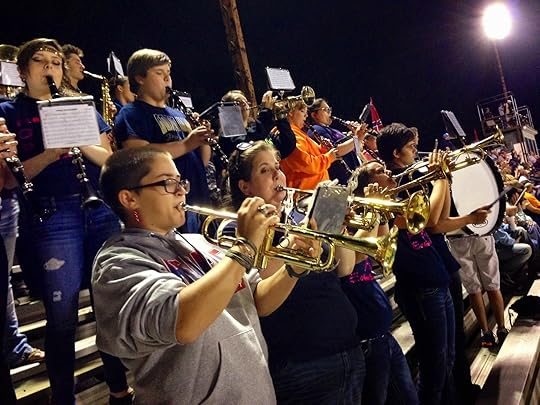
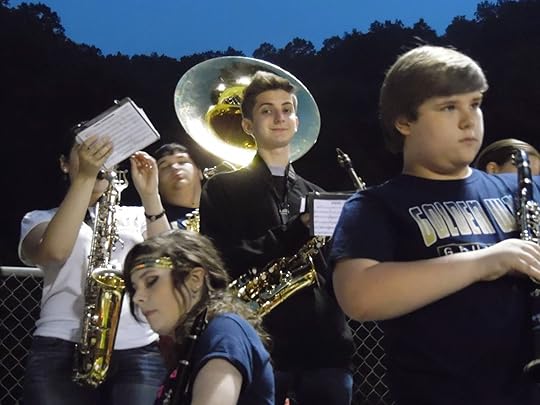

Published on September 13, 2014 17:21
July 5, 2014
My Review of Hiding Ezra by Rita Sims Quillen
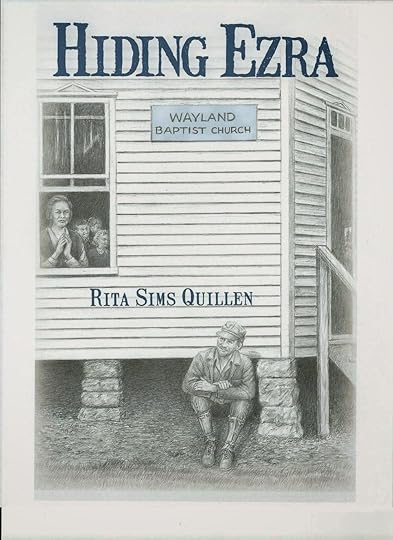 HIDING EZRA, by Rita Sims Quillen is a beautiful, at times heart-wrenching love story. Love story? How can I call the story of a WWI deserter, Ezra Teague a love story? Here’s how.
HIDING EZRA, by Rita Sims Quillen is a beautiful, at times heart-wrenching love story. Love story? How can I call the story of a WWI deserter, Ezra Teague a love story? Here’s how.Ezra Teague is a man who must choose between taking care of his family and fighting a war on the other side of the world – a war that he doesn’t understand. Living in the mountains of southwestern Virginia, Ezra Teague knows what it means to fight. He, like countless other pioneers, have fought to carve out a life on this rugged landscape. Why? LOVE. Ezra loves the mountains of his Scott County home. But don’t misunderstand Ezra. He is ready to fight for his country and reports for service with countless others.
Ezra finds himself in a predicament. His invalid father is helpless and must be cared for like an infant. His mother is dying, and the responsibility of his parents and the farm have fallen on his sister, Eva’s shoulders. When Ezra’s leave from the Army is up, he makes the decision not to return to Camp Lee. Ezra would rather hide in the mountains and risk the Army’s wrath, so he can watch over his family. His LOVE for his family surpasses his sense of duty.
For two years, Eza struggles to survive in the mountains while periodically being chased by Lieutenant Andrew Nettles, a native of Big Stone Gap, VA. Nettles inability to catch Ezra becomes a personal failing to the lieutenant, and he must reconcile his own feelings about how a man could choose his family over duty to his country. Lieutenant Nettles does indeed learn a lesson about LOVE from Ezra and the people who stand by him.
In the midst of this conflict is romantic LOVE. Her name is Alma Newton and strangely, their love grows while Ezra is on the run. It’s Alma love that helps Ezra find the strength to turn himself in, and it is her love, his sister’s love, and the love of his people that help Ezra move forward, and regain his life.
Rita Quillen is a brilliant poet and masterful storyteller. Her poet’s voice rings true throughout this novel. Ezra Teague’s story will remain with me for a very long time as I ponder his life, sacrifices and yes, love.
To learn more about HIDING EZRA visit the Facebook page. https://www.facebook.com/ritaquillenh... visit the author's website. http://www.ritasimsquillen.com/
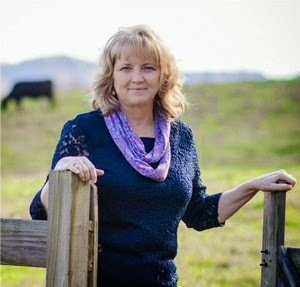
Published on July 05, 2014 14:43



